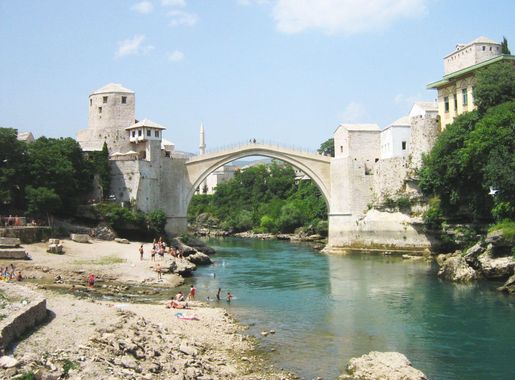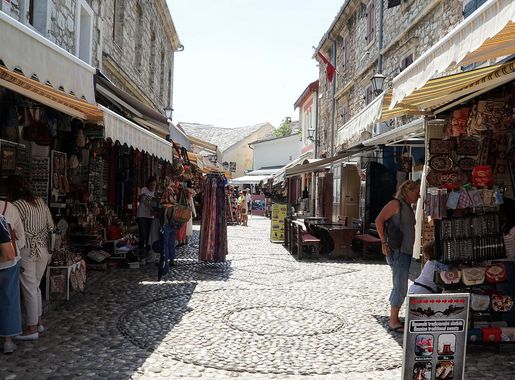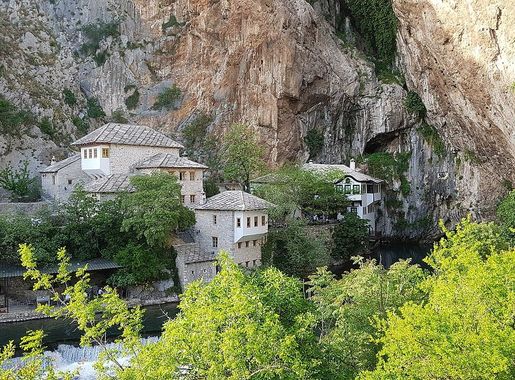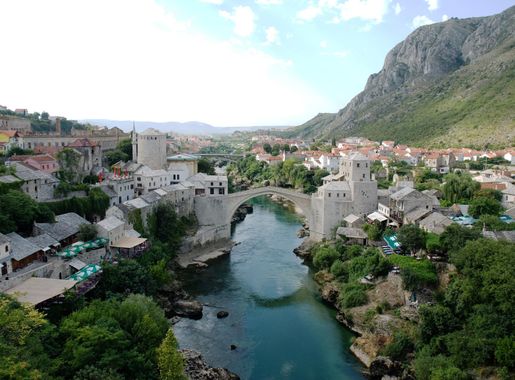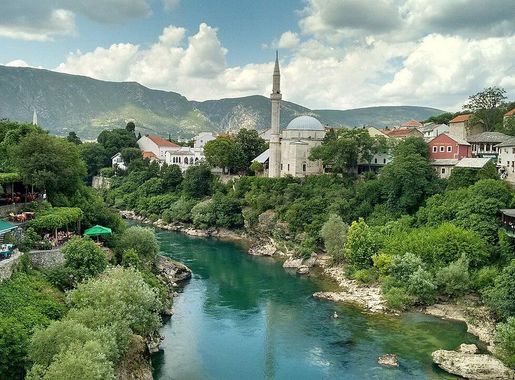
The Enchanting Heart of Bosnia and Herzegovina: Mostar Area
Discover the historic charm and natural beauty of Mostar, a city of resilience and cultural richness in Bosnia and Herzegovina, where past and present blend seamlessly.
Mostar, a gem in Bosnia and Herzegovina, is known for its historic bridge, Stari Most. This iconic structure, rebuilt after the war, symbolizes peace and resilience. The Old Town, with its Ottoman-era architecture, cobbled streets, and bustling markets, offers a glimpse into the past. Visitors can enjoy traditional Bosnian coffee in quaint cafes, surrounded by the sounds of the Neretva River. The Neretva River, with its emerald waters, is perfect for a summer swim or a scenic stroll along its banks. Adventurers can also experience white-water rafting. Don't miss the Koski Mehmed Pasha Mosque, which provides sweeping views of the city from its minaret. For a deeper understanding of the region's history, visit the Museum of War and Genocide Victims. The surrounding area of Mostar offers more treasures. The Kravice Waterfalls, a short drive away, are a natural wonder ideal for picnics and swimming. The village of Blagaj, with its serene Dervish Monastery built into a cliff, offers a tranquil escape. Wine lovers can explore the local vineyards and taste unique Herzegovinian wines. Mostar and its surroundings promise a rich, cultural, and adventurous experience for all travelers.
Local tips in Mostar Area
- Visit Stari Most at sunrise or sunset for the best photos and fewer crowds.
- Wear comfortable shoes for exploring the cobbled streets of the Old Town.
- Try traditional Bosnian dishes like Ćevapi or Burek at local restaurants.
- Bring cash, as some smaller shops and cafes might not accept credit cards.
- Take a day trip to Blagaj and Kravice Waterfalls for a complete experience.
The Enchanting Heart of Bosnia and Herzegovina: Mostar Area
Mostar, a gem in Bosnia and Herzegovina, is known for its historic bridge, Stari Most. This iconic structure, rebuilt after the war, symbolizes peace and resilience. The Old Town, with its Ottoman-era architecture, cobbled streets, and bustling markets, offers a glimpse into the past. Visitors can enjoy traditional Bosnian coffee in quaint cafes, surrounded by the sounds of the Neretva River. The Neretva River, with its emerald waters, is perfect for a summer swim or a scenic stroll along its banks. Adventurers can also experience white-water rafting. Don't miss the Koski Mehmed Pasha Mosque, which provides sweeping views of the city from its minaret. For a deeper understanding of the region's history, visit the Museum of War and Genocide Victims. The surrounding area of Mostar offers more treasures. The Kravice Waterfalls, a short drive away, are a natural wonder ideal for picnics and swimming. The village of Blagaj, with its serene Dervish Monastery built into a cliff, offers a tranquil escape. Wine lovers can explore the local vineyards and taste unique Herzegovinian wines. Mostar and its surroundings promise a rich, cultural, and adventurous experience for all travelers.
When is the best time to go to Mostar Area?
Iconic landmarks you can’t miss
Old Bridge Mostar
Discover the Old Bridge in Mostar, a UNESCO World Heritage site, and experience the charm of Bosnia and Herzegovina's rich cultural tapestry.

Fortica
Discover Fortica in Mostar, where adventure meets breathtaking views through thrilling zip-lining and scenic hiking trails.
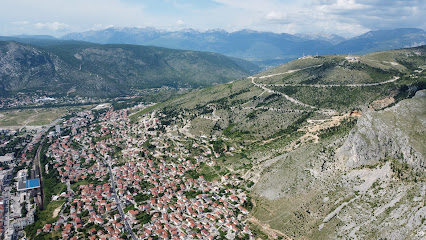
Park Zrinjevac
Discover the lush beauty and cultural vibrancy of Park Zrinjevac, Mostar's cherished green oasis for relaxation and social gatherings.
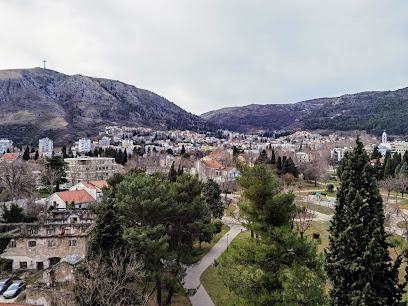
Karađoz Beg Mosque
Explore the Karađoz Beg Mosque, a stunning example of Ottoman architecture in Mostar, showcasing the rich Islamic heritage of Bosnia and Herzegovina.
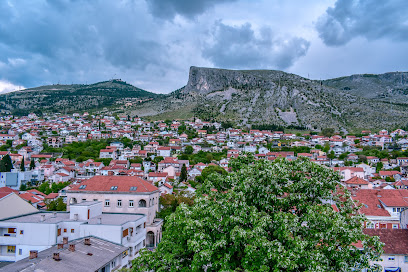
Mostar Peace Bell Tower
Experience the breathtaking views and rich symbolism of the Mostar Peace Bell Tower, a monument of hope in the heart of Bosnia and Herzegovina.

Koski Mehmed Pasha Mosque
Explore the Koski Mehmed Pasha Mosque in Mostar: A stunning blend of history, culture, and breathtaking views that captures the heart of Bosnia.

Millennium Cross
Discover breathtaking views and rich history at the iconic Millennium Cross in Mostar, a symbol of peace and unity in Herzegovina.
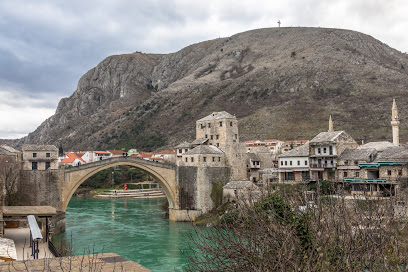
Titov Most
Experience the architectural beauty and historical significance of Titov Most, a stunning bridge in Mostar, Bosnia and Herzegovina, offering breathtaking views.
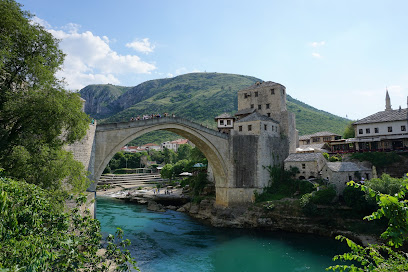
Museum Of War And Genocide Victims
Explore the Museum of War and Genocide Victims in Mostar for a profound understanding of Bosnia's turbulent history and the quest for peace.
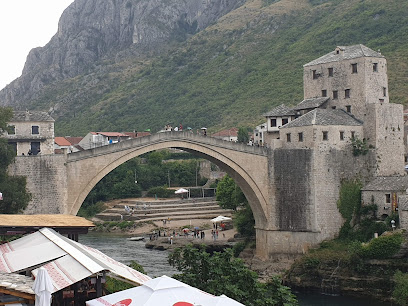
Cathedral of Mary, Mother of the Church
Discover the serene beauty and rich history of the Cathedral of Mary, Mother of the Church, a must-visit in Mostar.

Kriva ćuprija
Explore the historic beauty of Kriva Ćuprija, a stunning 16th-century bridge in Mostar that captures the essence of Bosnian heritage.
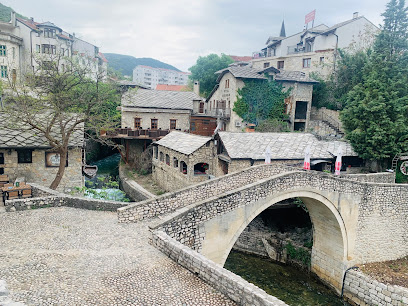
Lučki most
Discover the enchanting Lučki Most in Mostar, an architectural gem that symbolizes resilience and beauty amidst stunning landscapes.
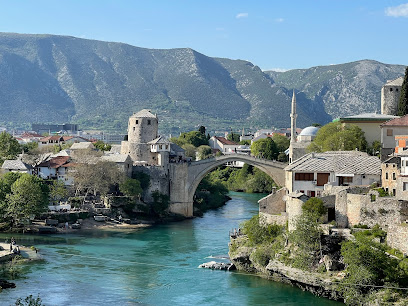
Muslibegovic House
Explore the rich heritage and stunning architecture of Muslibegovic House, a historical gem in the heart of Mostar, Bosnia.

Mostar Old Town
Discover the charm of Mostar Old Town, where history and culture meet in the stunning backdrop of the iconic Stari Most bridge.
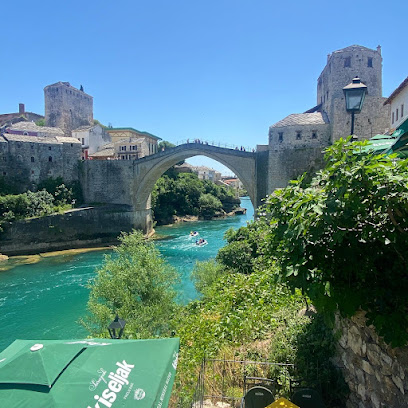
Biscevic House
Explore the historical Biscevic House in Mostar, a cultural landmark that beautifully showcases Bosnia's rich heritage through its preserved architecture and artifacts.
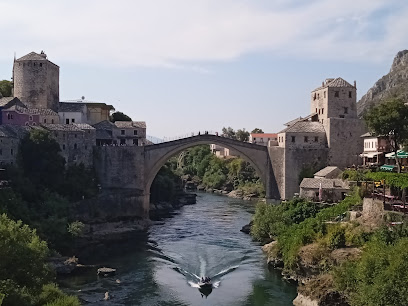
Unmissable attractions to see
Apparition Hill
Discover the serenity and spiritual richness of Apparition Hill in Bijakovići, a pilgrimage site that captivates hearts and souls.
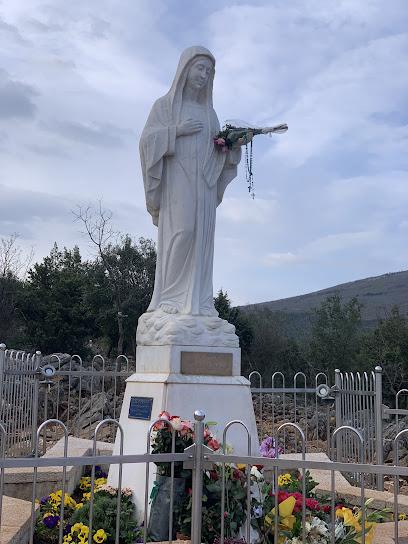
Počitelj Fortress
Explore the enchanting Počitelj Fortress in Bosnia and Herzegovina, a historical gem with stunning views and rich cultural heritage.
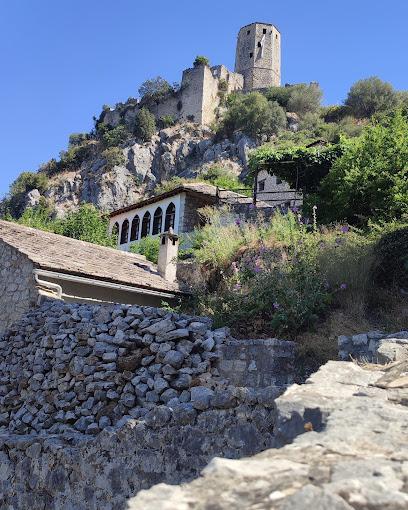
Lukomir viewpoint
Explore the stunning Lukomir Viewpoint in Bosnia for breathtaking mountain panoramas and a serene escape into nature's beauty.

Nekropole sa stećcima
Explore the UNESCO-listed Nekropole sa Stećcima, where ancient tombstones reveal the rich history and cultural heritage of Bosnia and Herzegovina.
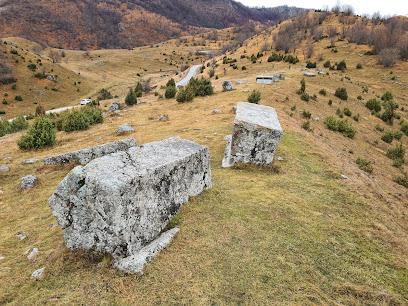
Tabhana
Experience the captivating charm of Tabhana, a must-see tourist attraction in Mostar that showcases the rich culture and stunning views of Bosnia.
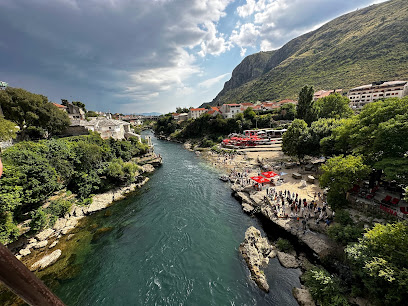
Trailhead
Experience the breathtaking beauty of Mostar's Trailhead, a premier hiking destination offering trails for all skill levels amidst stunning natural landscapes.
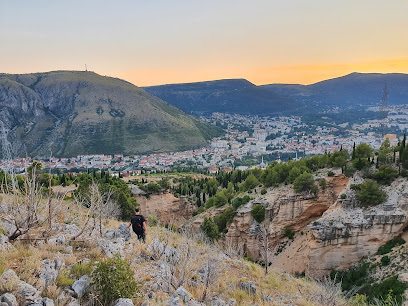
Mostarski kanjon
Discover the breathtaking beauty of Mostar Canyon, a hiking paradise in Bosnia and Herzegovina, offering stunning views and rich nature experiences.
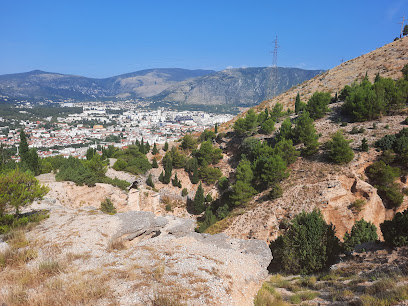
Bista Emine Sefić
Explore Bista Emine Sefić, a serene tourist attraction in Mostar, Bosnia and Herzegovina, reflecting the city's rich cultural heritage and history.
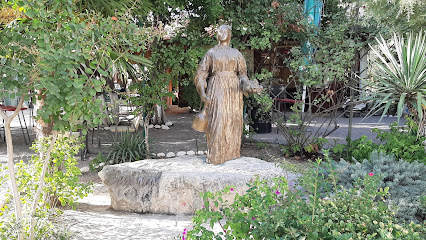
Wind Mills of Mostar
Experience the captivating beauty and rich history of the Wind Mills of Mostar in Bosnia and Herzegovina, a must-visit tourist attraction.
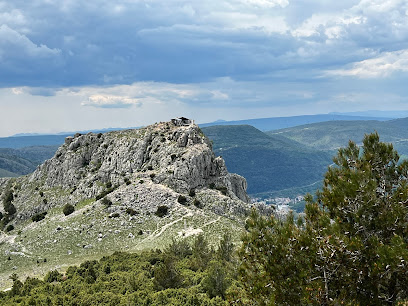
Yugotour Mostar
Explore the heart of Mostar at Yugotour, your gateway to stunning views, rich culture, and unforgettable experiences in Bosnia and Herzegovina.
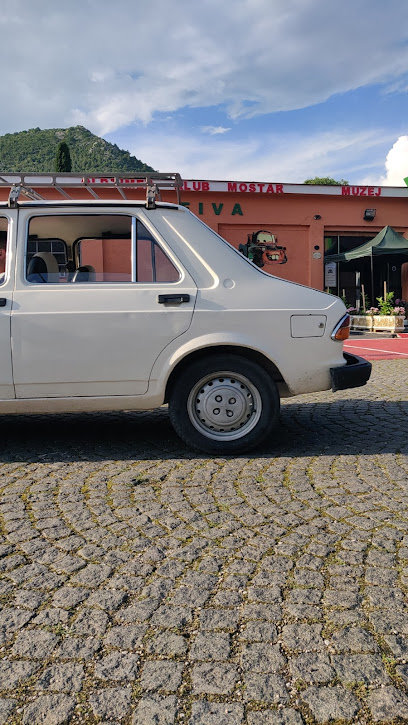
Essential places to dine
Restaurant Šadrvan
Experience authentic Eastern European cuisine at Restaurant Šadrvan in Mostar - where tradition meets flavor in a cozy atmosphere.
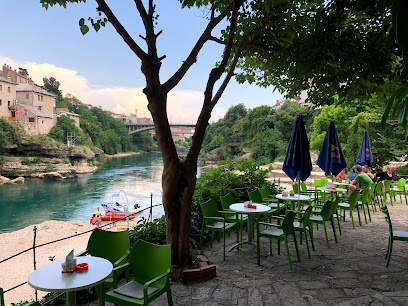
Tima - Irma
Discover Tima - Irma: A Traditional Barbecue Haven in Mostar Offering Authentic Bosnian Flavors.
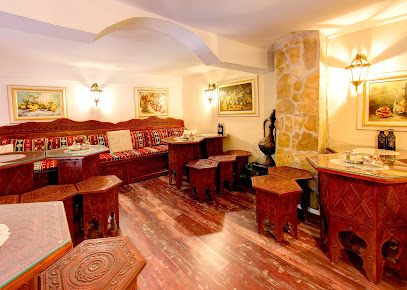
Hindin Han
Discover authentic Bosnian cuisine at Hindin Han in Mostar - where every dish tells a story.
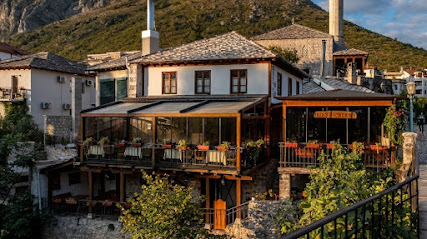
Megi
Experience authentic Bosnian cuisine at Megi in Mostar - where tradition meets modern culinary excellence.
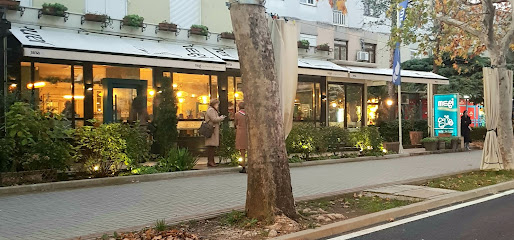
URBAN taste of orient
Discover authentic Bosnian cuisine at URBAN Taste of Orient in Mostar—where tradition meets modern culinary excellence.
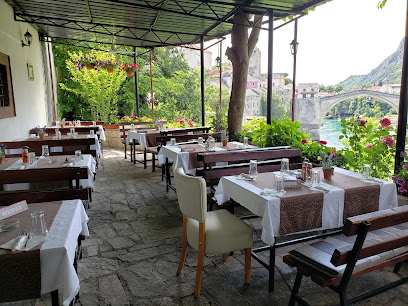
Restoran Labirint
Experience authentic Bosnian cuisine at Restoran Labirint near Stari Most in Mostar – a culinary journey you won't forget.

Del Rio
Discover authentic Bosnian flavors at Del Rio in Mostar—a delightful restaurant blending tradition with modern culinary creativity.
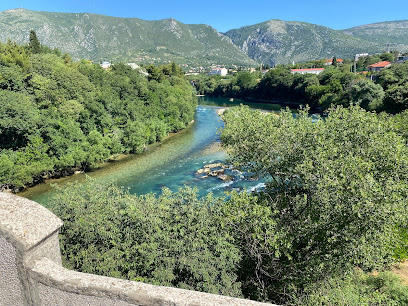
TABOO Bar Restaurant
Discover the flavors of Mostar at TABOO Bar Restaurant - where local tradition meets modern culinary artistry in an inviting atmosphere.
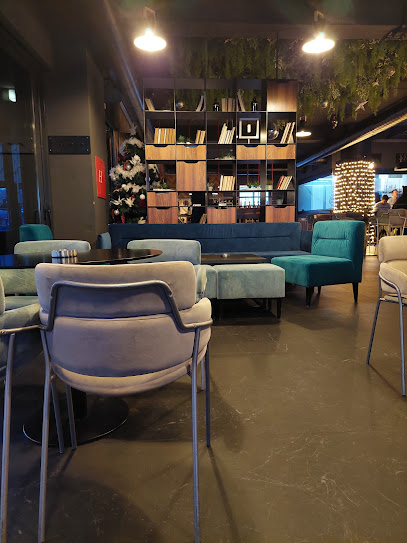
Food House Mostar
Experience authentic Bosnian flavors at Food House Mostar - a must-visit culinary destination for all food lovers.
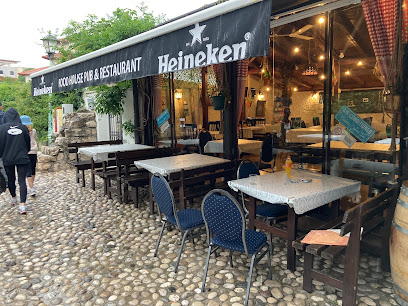
Restoran Radobolja
Discover Restoran Radobolja: A serene garden restaurant in Mostar offering traditional Bosnian cuisine perfect for families and special occasions.
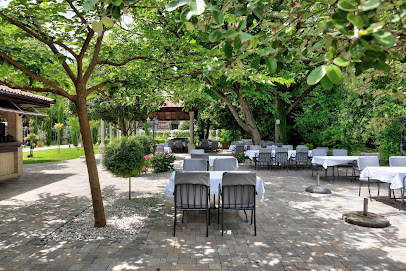
Restaurant Divan - Traditional Food, Fish, Meat Specialties & Wine Bar
Experience traditional Bosnian cuisine with fresh fish and meat specialties at Restaurant Divan in Mostar's vibrant culinary scene.
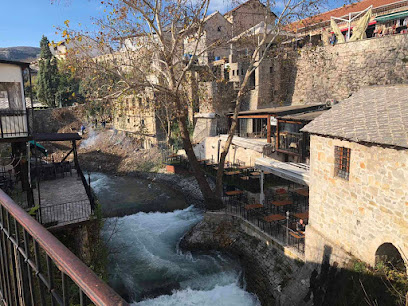
Pablo's Restaurant & Club
Experience the fusion of fine dining and nightlife at Pablo's Restaurant & Club in Mostar – where every meal is a celebration.
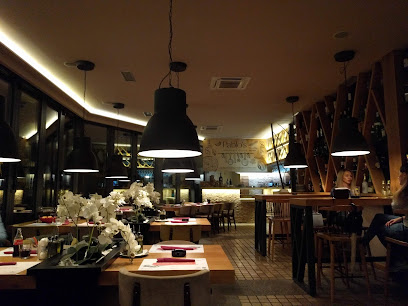
Terrace Lagero
Experience authentic Bosnian cuisine with stunning views at Terrace Lagero - where every meal becomes a memorable event.
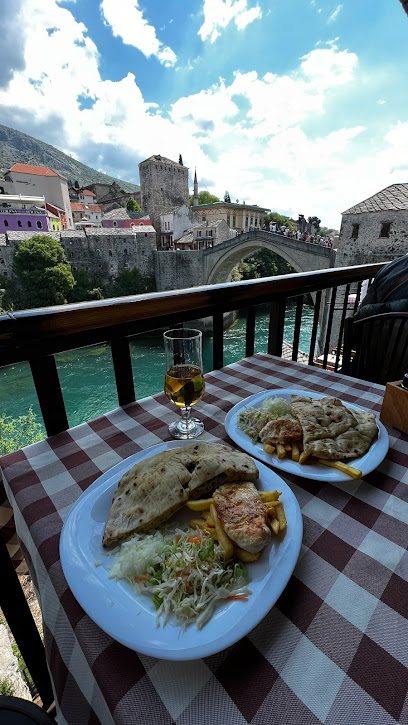
Blok bar & restaurant
Experience the best burgers and local flavors at Blok Bar & Restaurant in Mostar - a culinary treasure for food lovers.
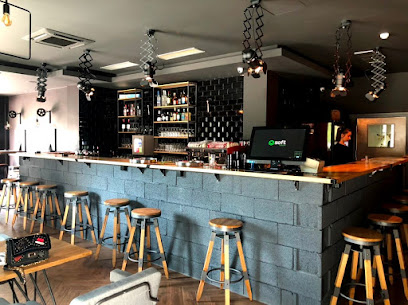
Restaurant Bella Vista
Experience authentic Bosnian cuisine with stunning views at Restaurant Bella Vista in Mostar.
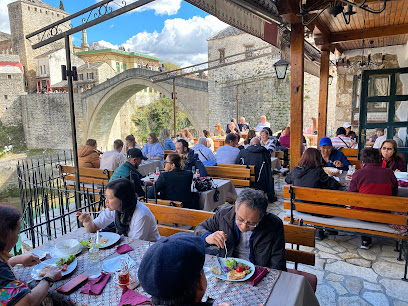
Markets, malls and hidden boutiques
Mepas Mall
Discover the vibrant shopping scene at Mepas Mall in Mostar, where local culture meets international brands and culinary delights.
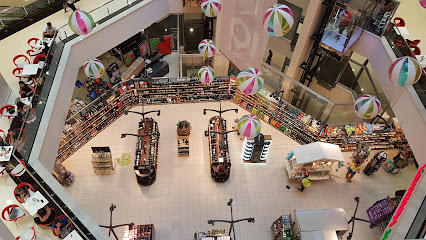
Piramida shopping centar
Experience modern shopping and local culture at Piramida Shopping Center, a must-visit destination in Mostar filled with boutiques, cafes, and wellness services.
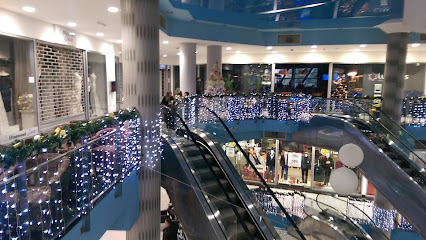
Megamarket
Explore a shopping paradise at Megamarket in Mostar, where local charm meets international brands for an unforgettable retail experience.
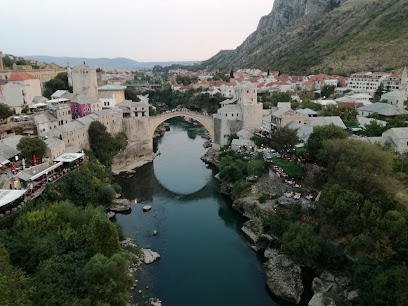
LC Waikiki Mostar Outlet
Explore stylish clothing at LC Waikiki Mostar Outlet, where fashion meets affordability in the heart of Mostar.

Prodajni centar Mostar
Discover the heart of shopping in Mostar at Prodajni Centar, a vibrant mall offering diverse shops, delightful dining, and a taste of local culture.
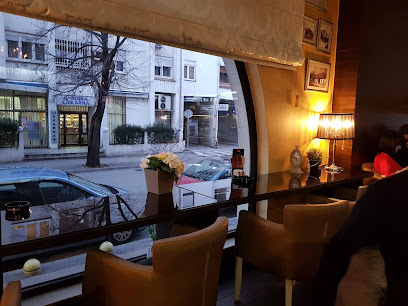
RETRO - Kuća mode
Explore Retro - Kuća mode in Mostar for trendy men's and women's clothing that showcases local style and contemporary flair.
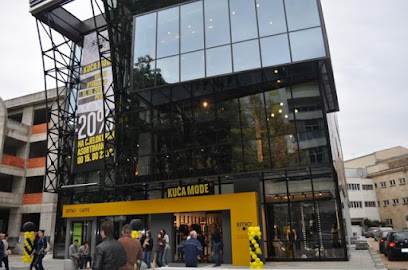
ZARA
Explore trendy fashion at ZARA in Mostar, where style meets affordability in a vibrant shopping experience.
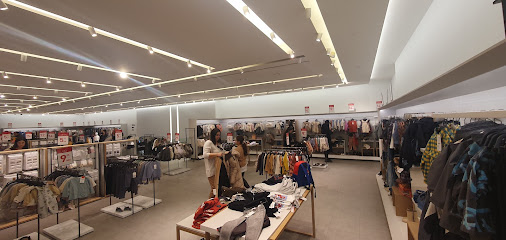
Bazar Kujundžiluk
Discover the charm of Bazar Kujundžiluk in Mostar, a market brimming with local crafts, delicious food, and vibrant culture.
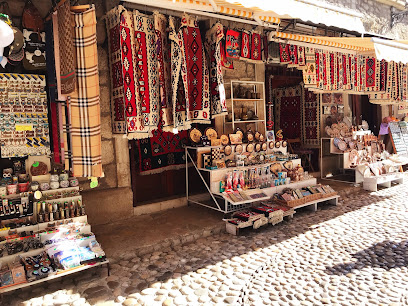
Sport Vision Outlet Mostar
Shop smart at Sport Vision Outlet Mostar for discounted sports apparel and gear in a vibrant shopping atmosphere.
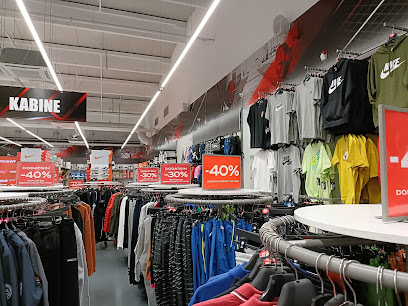
Azel France
Explore Azel France in Mostar for a unique shopping experience that blends local culture with contemporary fashion.
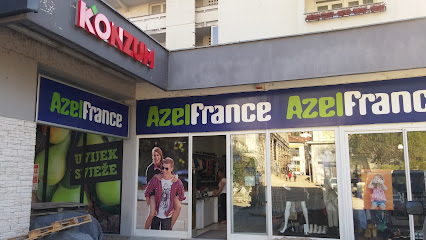
The Spirit of Herzegovina
Explore the Heart of Herzegovina: Unique Gifts, Local Wines, and Authentic Culture Await You at The Spirit of Herzegovina.
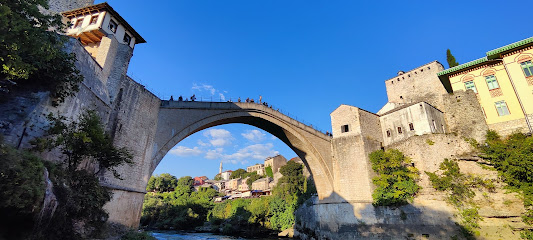
Textile House
Explore the charming Textile House in Mostar for unique vintage clothing and sustainable fashion treasures that tell a story.

Tobacco Shop
Discover the charming Tobacco Shop in Mostar, where the rich aromas of tobacco meet the world of literature in a cozy cultural hub.

Bazaar In Mostar
Explore the rich culture of Bosnia and Herzegovina at the Bazaar in Mostar, where unique souvenirs and local crafts await every visitor.
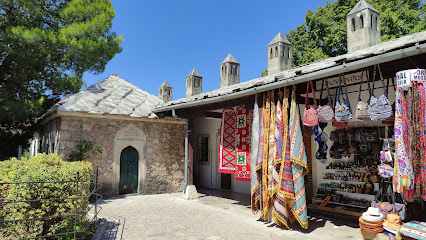
NAMFLEG Mostar Jewelry& Watches
Explore the finest selection of handcrafted jewelry and unique souvenirs at NAMFLEG Mostar Jewelry & Watches, where tradition meets elegance.
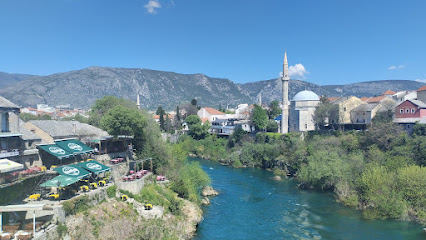
Essential bars & hidden hideouts
Shankly's Pub
Discover the heart of Mostar at Shankly's Pub - where culture, community, and great food meet in a vibrant atmosphere.

Gastro Pub Gonzales
Experience the best of Bosnian and international cuisine at Gastro Pub Gonzales in Mostar, where every meal is a celebration of flavor.
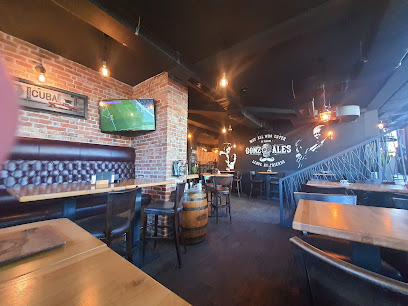
TABOO Bar Restaurant
Experience the vibrant atmosphere and exquisite flavors of TABOO Bar Restaurant in Mostar, where culinary tradition meets modern dining.
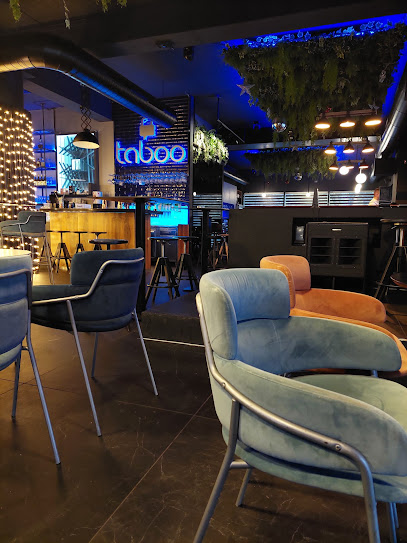
Black Pearl
Discover Black Pearl Cafe in Mostar – a perfect blend of cozy ambiance and an extensive cocktail menu awaits you in this charming city.
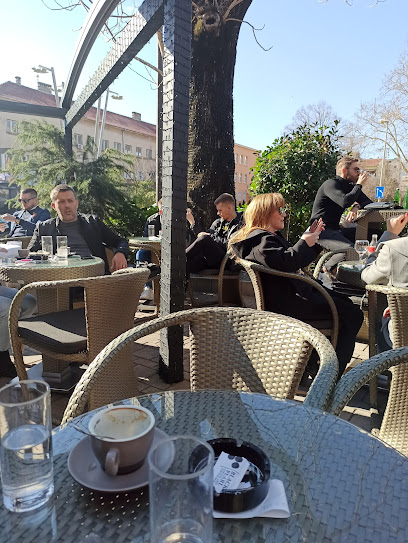
Hemingway Bar
Discover the charm of Mostar at Hemingway Bar, where cocktails and café culture unite for a memorable experience.

Mazel Tov Concept Bar
Discover Mazel Tov Concept Bar in Mostar, a lively bar offering a unique blend of local flavors and a vibrant atmosphere for tourists.

Craft Beer Garden imaimoze
Experience the best of Bosnia's craft beer culture at Craft Beer Garden Imaimoze, a perfect spot for relaxation and enjoyment in Mostar.
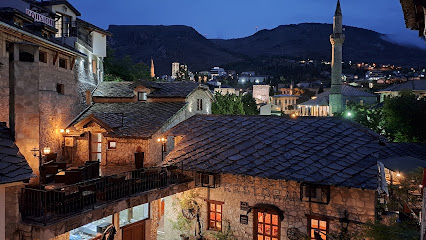
Von Herzog
Discover the lively ambiance and local charm at Von Herzog, the perfect pub in Mostar for tourists seeking a taste of authentic Bosnian culture.
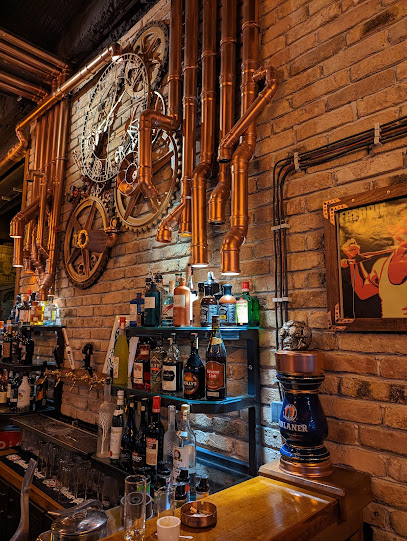
Pub Beer ti&ja
Discover the best of local brews and delicious fare at Pub Beer ti ja, a vibrant gastropub experience in the heart of Mostar.
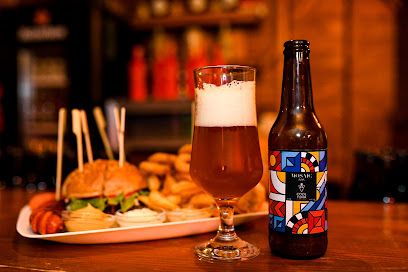
Charlie - bar & snack
Experience the best of Mostar at Charlie - Bar & Snack, where local flavors meet a vibrant atmosphere in the heart of the city.
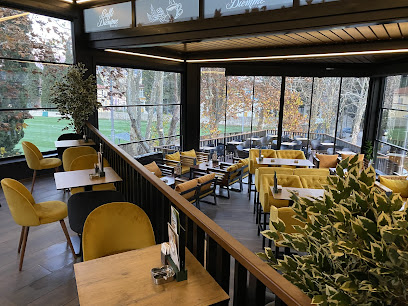
Caffe Bar Fratello
Discover the charm of Caffe Bar Fratello in Mostar, where local culture meets a cozy ambiance for an unforgettable experience.
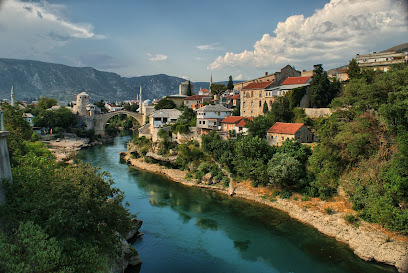
The Rebels pub
Discover the vibrant spirit of Mostar at The Rebels Pub, where local flavors meet a lively atmosphere for an unforgettable night.

Night Bar Duradzik
Discover Mostar's lively nightlife at Night Bar Duradzik, where great drinks and vibrant atmosphere await in the historic Kujundžiluk district.
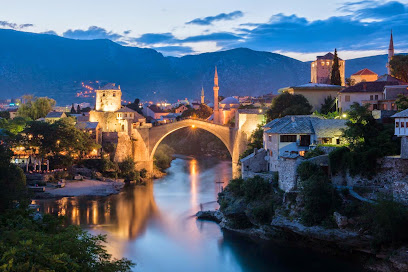
Terasa
Discover Terasa: A cocktail bar in Mostar offering exquisite drinks, stunning views, and a vibrant atmosphere perfect for any occasion.
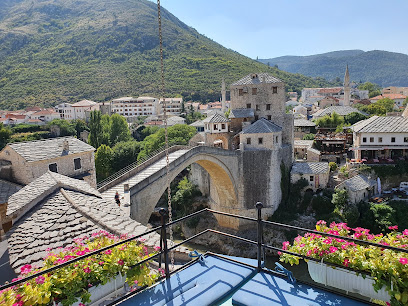
Ljetna bašta
Discover Ljetna Bašta in Mostar, a serene bar with a stunning outdoor garden, perfect for enjoying local drinks and experiencing the vibrant culture.
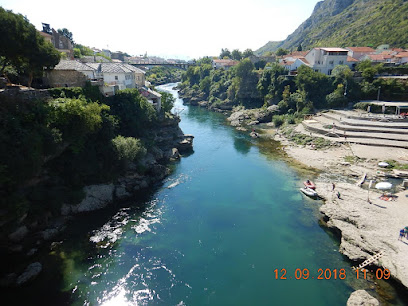
Local Phrases about Mostar Area
-
- HelloZdravo
[Zdrah-voh] - GoodbyeDoviđenja
[Doh-vee-jen-ya] - YesDa
[Dah] - NoNe
[Neh] - Please/You're welcomeMolim
[Moh-leem] - Thank youHvala
[Hvah-lah] - Excuse me/SorryIzvini
[Eez-vee-nee] - How are you?Kako si?
[Kah-koh see?] - Fine. And you?Dobro. A ti?
[Doh-broh. Ah tee?] - Do you speak English?Govoriš li engleski?
[Go-vo-reesh lee eng-les-kee?] - I don't understandNe razumijem
[Neh rah-zoo-mee-yem]
- HelloZdravo
-
- I'd like to see the menu, pleaseMogu li vidjeti meni, molim
[Moh-goo lee veed-yeh-tee meh-nee, moh-leem] - I don't eat meatNe jedem meso
[Neh yeh-dem meh-so] - Cheers!Živjeli!
[Zhee-ve-lee] - I would like to pay, pleaseŽelim platiti, molim
[Zheh-leem pla-tee-tee, moh-leem]
- I'd like to see the menu, pleaseMogu li vidjeti meni, molim
-
- Help!Pomoć!
[Poh-mohtch!] - Go away!Idi odavde!
[Ee-dee oh-dahv-deh!] - Call the Police!Pozovi policiju!
[Poh-zoh-vee poh-lee-tsee-yoo!] - Call a doctor!Pozovi doktora!
[Poh-zoh-vee dohk-toh-rah!] - I'm lostIzgubio/la sam se
[Eez-goo-bee-oh/lah sahm seh] - I'm illBolestan/sna sam
[Boh-leh-stahn/snah sahm]
- Help!Pomoć!
-
- I'd like to buy...Želim kupiti...
[Zheh-leem koo-pee-tee] - I'm just lookingSamo gledam
[Sah-moh gleh-dahm] - How much is it?Koliko košta?
[Koh-lee-koh koh-shta?] - That's too expensiveTo je previše skupo
[To yeh preh-vee-sheh skoo-poh] - Can you lower the price?Možete li spustiti cijenu?
[Moh-zheh-teh lee spoos-tee-tee tsee-yeh-noo?]
- I'd like to buy...Želim kupiti...
-
- What time is it?Koliko je sati?
[Koh-lee-koh yeh sah-tee?] - It's one o'clockJedan je sat
[Yeh-dahn yeh saht] - Half past (10)Pola (deset)
[Poh-lah (deh-set)] - MorningJutro
[Yoo-troh] - AfternoonPopodne
[Poh-pohd-neh] - EveningVeče
[Veh-cheh] - YesterdayJučer
[Yoo-chehr] - TodayDanas
[Dah-nahs] - TomorrowSutra
[Soo-trah] - 1Jedan
[Yeh-dahn] - 2Dva
[Dvah] - 3Tri
[Tree] - 4Četiri
[Cheh-tee-ree] - 5Pet
[Peh-t] - 6Šest
[Shehst] - 7Sedam
[Seh-dahm] - 8Osam
[Oh-sahm] - 9Devet
[Deh-veht] - 10Deset
[Deh-set]
- What time is it?Koliko je sati?
-
- Where's a/the...?Gdje je...
[Gdyeh yeh] - What's the address?Koja je adresa?
[Koh-yah yeh ah-deh-srah] - Can you show me (on the map)?Možete li mi pokazati (na mapi)?
[Moh-zheh-teh lee mee poh-kah-zah-tee (nah mah-pee)] - When's the next (bus)?Kada je sljedeći (autobus)?
[Kah-dah yeh sleh-deh-chee (ow-toh-boos)] - A ticket (to ....)Jednu kartu (za ....)
[Yeh-dnoo kar-too (zah)]
- Where's a/the...?Gdje je...
History of Mostar Area
-
Mostar was founded in the 15th century during the Ottoman Empire's expansion into the Balkans. It quickly grew into an important administrative and commercial center. The iconic Stari Most (Old Bridge) was constructed in 1566 by the renowned Ottoman architect Mimar Sinan’s apprentice, Mimar Hayruddin. The bridge became an architectural marvel of its time and a symbol of unity and connection.
-
Following the decline of the Ottoman Empire, Mostar fell under Austro-Hungarian rule in 1878. This period saw significant urban development and modernization. Many European-style buildings were constructed, blending Western architectural elements with the existing Ottoman structures. The railway connecting Mostar to Sarajevo and further to the Adriatic Sea was also introduced, boosting trade and transportation.
-
During World War II, Mostar was part of the Independent State of Croatia, a puppet state of Nazi Germany and Fascist Italy. The city experienced occupation, resistance, and significant destruction. After the war, Mostar became part of the Socialist Federal Republic of Yugoslavia. The rebuilding process focused on restoring the city's infrastructure and harmonizing its diverse cultural heritage.
-
Under Yugoslav rule, Mostar thrived as an industrial and cultural hub. The city’s diverse population of Bosniaks, Croats, and Serbs coexisted relatively peacefully. Mostar was known for its vibrant cultural scene, with numerous festivals, theaters, and sports events. The Stari Most remained a symbol of multicultural harmony during this period.
-
The Bosnian War (1992-1995) had a devastating impact on Mostar. The city witnessed intense fighting between Bosniak and Croat forces, leading to severe destruction, including the tragic demolition of the Stari Most in 1993. The war caused immense human suffering and left deep scars on the community. Post-war efforts focused on rebuilding and reconciliation.
-
Following the Bosnian War, extensive efforts were made to reconstruct Mostar and restore its cultural landmarks. The Stari Most was meticulously rebuilt and reopened in 2004. In 2005, the bridge and the Old Town of Mostar were inscribed as UNESCO World Heritage Sites, recognizing their historical significance and the successful restoration efforts. Today, Mostar stands as a testament to resilience and cultural heritage.
-
Today, Mostar is a vibrant city that attracts tourists from around the world. It is celebrated for its stunning architecture, rich history, and diverse cultural traditions. The city hosts various cultural events and festivals, such as the Mostar Summer Fest and the traditional diving competition from the Stari Most. Mostar continues to be a symbol of multicultural coexistence and resilience.
Mostar Area Essentials
-
Mostar is located in the Herzegovina region of Bosnia and Herzegovina. The nearest international airport is Mostar International Airport (OMO), located about 7 kilometers from the city center. Sarajevo International Airport (SJJ) is another option, approximately 130 kilometers away. From Sarajevo, you can take a train or a bus to Mostar, which usually takes around 2 to 3 hours. Alternatively, you can drive or hire a taxi for the journey. There are also regular bus services from Dubrovnik and Split in Croatia, which are popular entry points for travelers.
-
Mostar is a relatively small city, and its main attractions are within walking distance. Local buses and taxis are readily available for longer trips within the city and to nearby areas. Car rental services are also available for those who prefer to explore the region at their own pace. The train and bus stations are centrally located, making it easy to catch public transport to other cities and towns in Bosnia and Herzegovina.
-
The official currency in Bosnia and Herzegovina is the Convertible Mark (BAM). Credit cards are widely accepted in hotels, restaurants, and larger shops, but it's advisable to carry cash, especially when visiting smaller establishments and rural areas. ATMs are plentiful in Mostar, and many offer instructions in English. It's a good idea to have some local currency on hand for incidental purchases.
-
Mostar is generally considered a safe destination for tourists. However, it's important to exercise common sense and standard precautions. Avoid walking alone at night in poorly lit or unfamiliar areas. Keep an eye on your belongings in crowded places, such as markets and public transport. There are no specific high-crime areas targeting tourists, but staying vigilant and aware of your surroundings is always best.
-
In case of emergency, dial 112 for immediate assistance. This number connects you to police, ambulance, and fire services. The local police station and medical facilities, including hospitals and clinics, are available in Mostar. It's recommended to have travel insurance that covers medical emergencies. For minor health issues, there are several pharmacies in the city where you can purchase over-the-counter medications.
-
Fashion: Do dress modestly, especially when visiting religious sites. Avoid wearing overly revealing clothing. Religion: Do respect local customs and traditions. When entering mosques or churches, dress appropriately and follow any specific rules, such as removing shoes or covering your head. Public Transport: Do be respectful to fellow passengers and give up your seat to elderly or disabled individuals. Don't eat or drink on public transport. Greetings: Do greet people with a handshake and maintain eye contact. A smile goes a long way in creating a positive first impression. Eating & Drinking: Do try local dishes and accept food offerings graciously. Don't refuse hospitality, as it is considered impolite.
-
To experience Mostar like a local, visit the Old Bazaar (Kujundžiluk), where you can find traditional crafts and souvenirs. Engage with locals, who are often friendly and willing to share stories about the city's history and culture. Don't miss the iconic Stari Most (Old Bridge) and its surrounding area, a UNESCO World Heritage Site. For a unique experience, attend a local coffee shop and try Bosnian coffee. Additionally, exploring the nearby Blagaj Tekke, a Dervish monastery built at the base of a cliff, offers a serene and historical experience.
Trending Landmarks in Mostar Area
Nearby Cities to Mostar Area
-
Things To Do in Makarska
-
Things To Do in Sarajevo
-
Things To Do in Dubrovnik
-
Things To Do in Trebinje
-
Things To Do in Hvar
-
Things To Do in Zenica
-
Things To Do in Split
-
Things To Do in Nikšić
-
Things To Do in Herceg Novi
-
Things To Do in Jajce
-
Things To Do in Perast
-
Things To Do in Tivat
-
Things To Do in Trogir
-
Things To Do in Kotor
-
Things To Do in Cetinje

